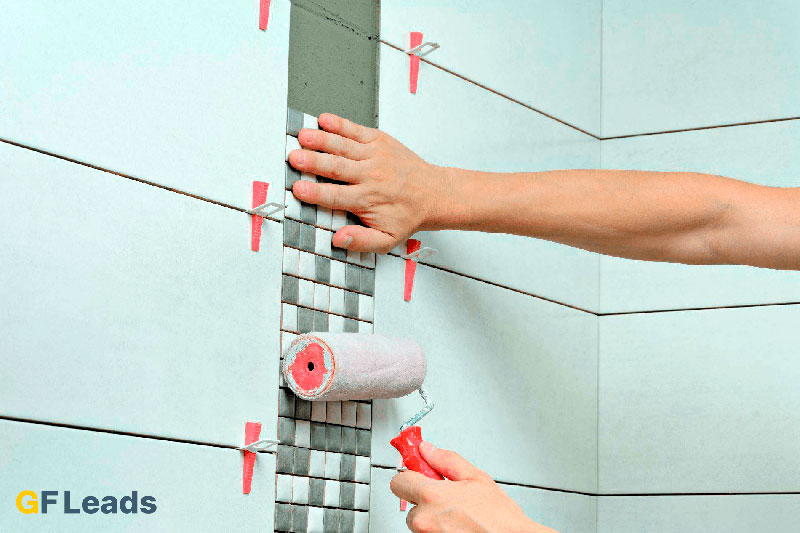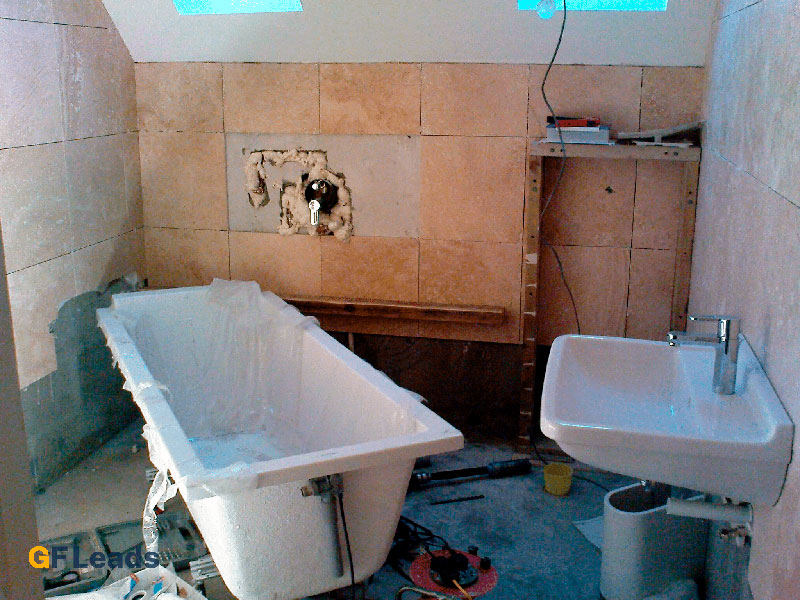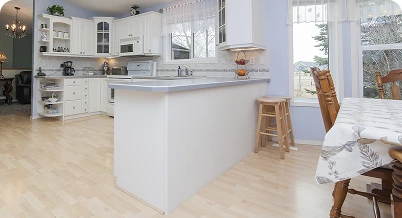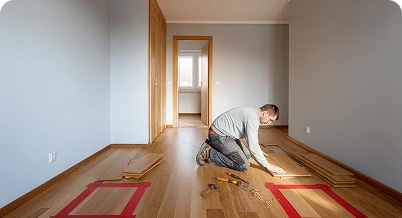Bathroom renovation: modern materials, technologies and professional solutions
GF Leads, 22 July, 2025
The bathroom is one of the most difficult rooms to renovate. It combines high requirements for moisture resistance, practicality and aesthetics. The modern market offers many solutions, but how do you choose the one that suits you?
GFLeads specializes in connecting repair technicians and clients across the United States. We will not only talk about modern technologies, but also offer:
An affiliate program – recommend our services and get rewarded for leads.
Purchase leads – if you are a foreman or a construction crew, we have verified your requests.
1. Preparation and selection of materials for finishing
The right choice of materials is the key to the durability of repairs. Consider the popular options:
1.1. Tiles
Tiles – ceramic tiles, glass mosaics or large-format porcelain stoneware, all of them require a flat base, but not perfect. The plane (horizontal or vertical) should not have a strong deviation from the level, should be without pronounced bumps and depressions or potholes. Tile adhesive is applied in a thin layer, it is not suitable for global leveling of the floor and walls. Usually, high-quality wall plastering or putty is enough for tiles.
Ceramic tiles are classics for bathrooms. It requires a smooth, but not perfect foundation.
Porcelain stoneware is more durable, suitable for floors and walls.
Glass mosaic is a stylish option for accent areas.
Important: The base must be free of strong fluctuations (small irregularities are acceptable). Plaster or putty is used for leveling.
1.2. Water-resistant paints
Waterproof paints are used on walls in areas where there is no direct water ingress. They require perfectly smooth and polished walls. Not compatible with some types of waterproofing.
Suitable for areas without direct contact with water.
They require perfectly smooth walls.
Incompatible with some types of waterproofing.
1.3. MDF panels
MDF panels are installed most often on a metal or wood frame, they require smooth walls, like tiles, but they are tolerant of small defects in the walls. It is recommended to install it outside the direct water access zone, although there are even screens for an MDF bathtub.
They are mounted on a frame.
They are not afraid of moisture, but are undesirable in areas of direct water ingress.
They are suitable for quick repairs without dirty work.
1.4. Quartz vinyl laminate
Quartz vinyl laminate – fits both on the floor and on the walls. An ideal base will need to be prepared for the floor, most often a self-leveling floor is used. It is attached to the walls either through a crate or on liquid nails, in the first case, leveling to perfect smoothness is not necessary.
A waterproof analogue of a conventional laminate.
A perfectly flat base (self-leveling floor) is required for the floor.
It is attached to the walls with a crate or glue.
1.5. Microcement
Micro–cement is a mixture of polymers and cement with the addition of coloring pigments that makes it possible to obtain a durable, moisture-resistant and stylish coating for any loft-style interior, minimalism, etc. It requires preliminary leveling of walls and floors, since it is applied in a thin layer and will emphasize any surface defects.
A modern loft-style and minimalist solution.
Moisture-resistant, durable, applied in a thin layer.
It requires a perfectly flat surface.
2. Wall and floor alignment

2.1. Plaster
Plaster is used for brick walls with a high level of unevenness. Cement is recommended for tiles, but gypsum is often made, it needs waterproofing.
For brick walls with large irregularities.
It is better to use cement under the tile (gypsum requires waterproofing).
2.2. Drywall (moisture-proof)
Drywall is moisture–resistant - it is used for heavily "blocked" walls, more than 5 cm. Its disadvantage is that it "eats up" the area, because it is mounted on a crate or metal frame. Therefore, if the drop in the wall plane is small, drywall is rarely used. But among the advantages, it is worth noting the possibility of hidden pipe laying without crushing the walls. Sometimes it's important.
Suitable for drops of more than 5 cm.
Allows you to hide communications without splitting.
2.3. Aquapanels
Aquapanels are cement slabs that can withstand installation outside a building, meaning they are absolutely not afraid of moisture. They are mounted on a frame.
Absolutely moisture-resistant, mounted on a frame.
They are suitable even for outdoor work.
2.4. Putty
Putty is a universal material for leveling small defects on walls. It is used on cladding from GVLV, PGP, aquapanels for sealing joints. It is also used for leveling walls for painting. In bathrooms, it is recommended to use a special moisture-resistant putty based on polymer or acrylic. The main thing is to check that it is compatible with your finishing material: tiles or paint.
For finishing leveling of small defects.
It is used for painting and tiling.
3. Waterproofing – protection against moisture and leaks
Waterproofing is an important step in bathroom renovation, which protects the walls, floor and ceiling from moisture penetration. Properly executed waterproofing prevents the appearance of mold, mildew and the destruction of building structures.
Without high-quality waterproofing, even the most expensive repairs will quickly become unusable.
3.1. Coating waterproofing
Cement is durable, but inelastic.
Polymer (polyurethane) – flexible, fills cracks.
3.2. Roll waterproofing
Bitumen materials on fiberglass.
They are used before pouring the screed.
3.3. Penetrating waterproofing
Fills the pores of concrete, increasing water resistance.
It is not suitable for porous materials (foam blocks).
4. Ventilation – how to avoid mold?
Natural ventilation is often insufficient. We recommend
installing an exhaust fan (with timer or humidity sensor).
Pre-install the wiring at the roughing stage.
Choose quiet models (important for bathrooms next to the bedroom).
5. Tile corner decoration
5.1. Overhead corners (plastic)
Cheap, but short-lived.
Suitable for budget repairs.
5.2. Washed down at 45°
Aesthetically pleasing, but expensive and fragile (not for thin tiles).
5.3. Metal layout
Sturdy, stylish, and durable.
Options: aluminum, stainless steel, brass
6. Grouting joints – which one is better?
Type of grout Pros and Cons
Cement-based Inexpensive, easy to apply, Unstable to water
Latex Moisture-resistant, elastic Is More Expensive than cement
Epoxy Maximum Strength Is difficult to work with, expensive
Tip: Use only epoxy grout for shower areas!
Why is it worth working with GFLeads?

1. For craftsmen and construction crews
Buy high–quality leads - we provide verified requests from customers who are already interested in repair services.
Fixed prices – the cost of leads is transparent and depends only on the staff and type of work.
A wide range of areas – plumbing, flood repairs, roofing, and more.
2. For partners (publishers and craftsmen)
Recommend our services and get rewarded by simply sharing a link or phone number with potential customers.
A convenient personal account – all your requests and payments in one place.
There are many specialized landing pages – we have a separate website for each area of repair, which makes it easier to attract customers.
How do GFLeads help with repairs?
We are working in two directions.:
- Affiliate program – recommend the services of craftsmen to your clients and receive a fixed reward.
- Selling leads – if you are a builder or plumber, buy ready-made applications from us.
GFLeads – only for the USA!
- For publishers (blogs, forums) – monetize traffic by recommending our services.
- For the masters, you can find clients without spending extra money on advertising.
Sign up now and start earning with GFLeads!
Table of content
- 1. Preparation and selection of materials for finishing
- 2. Wall and floor alignment
- 3. Waterproofing – protection against moisture and leaks
- 5. Tile corner decoration
- 6. Grouting joints – which one is better?
- Why is it worth working with GFLeads?


